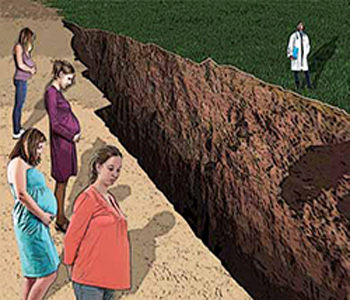Is private ObGyn practice on its way out?
Lucia DiVenere (October 2011)
Medicare and Medicaid are on the brink of insolvency, and you’re not just a bystander
Robert L. Barbieri, MD (Editorial, October 2011)
14 questions (and answers) about health reform and you
Janelle Yates, Senior Editor, with Lucia DiVenere (July 2010)
Is the patient-centered medical home a win-all or lose-all proposition for ObGyns?
Janelle Yates (October 2010)
Ms. DiVenere reports no financial relationships relevant to this article.
Tough economic times have pushed 2.8 million more people onto Medicaid rolls, now crowded with more than 60 million low-income individuals and families—nearly 20% of the US population.
Because Medicaid is a means-tested entitlement program, states and the federal government must fund as much health care as beneficiaries use, an expense that increases substantially each year.
Through the Medicaid program, more than 30 million adult women have access to an annual gynecologic exam, family planning services, and prenatal care. Without such coverage, many of them would go without care, potentially driving our nation’s health-care costs even higher. Two thirds of ObGyns treat Medicaid patients, and Medicaid accounts for 18%, on average, of an ObGyn practice’s revenue.1
In this article, I describe how the burgeoning ranks of Medicaid beneficiaries are straining state budgets and prompting legislators to cut provider payments to make up the shortfall. The federal government also plays a role in shrinking reimbursements for physicians and other providers.

Medicaid costs are outpacing economic growth
In fiscal 2011, Medicaid enrollment grew an average of 5.5%, and states are anticipating a growth rate of 4.1% in 2012.2 Total Medicaid spending is also increasing rapidly. In fiscal 2010, it was $361.8 billion (excluding administrative costs)—a 6% increase over fiscal 2009. By the end of fiscal 2011, it was expected to hit $398.6 billion—a 10.1% increase over 2010.3
Medicaid costs are also absorbing a greater share of state budgets. In fiscal 2009, they accounted for 21.9% of total state expenditures, 22.3% in fiscal 2010, and 23.6% in fiscal 2011.3 Many states have had to reduce spending in other important areas as a result (TABLE 1).
Medicaid costs are shared by federal and state governments. The federal government pays, on average, 57% of state program costs. In fiscal 2010, the federal government covered 64.6% of all Medicaid costs.
State general funds at the end of 2011 were well below their pre-recession levels, due to lower revenues and increased expenditures, including continued obligations for state workers’ pensions and retiree health care. At the same time, 49 state governments are required to balance their budgets. As a result, states are likely to face austere budgets for at least the next several years, and will continue to make difficult spending decisions.
As state and federal budgets face pressure to reduce overall spending, Medicaid lies in nearly all budget crosshairs.
TABLE 1
Medicaid absorbs an ever-greater percentage of state expenditures
| State | Percentage | ||
|---|---|---|---|
| Fiscal 2009 | Fiscal 2010 | Fiscal 2011 | |
| New England | |||
| Connecticut | 27.9 | 25.4 | 27.2 |
| Maine | 29.9 | 28.6 | 28.6 |
| Massachusetts | 17.8 | 18.8 | 20.2 |
| New Hampshire | 26.5 | 24.9 | 25.2 |
| Rhode Island | 24.9 | 25.0 | 24.7 |
| Vermont | 25.5 | 25.9 | 26.6 |
| Mid-Atlantic | |||
| Delaware | 12.3 | 14.4 | 16.2 |
| Maryland | 19.3 | 20.4 | 21.6 |
| New Jersey | 19.8 | 21.3 | 21.9 |
| New york | 26.7 | 28.7 | 29.1 |
| Pennsylvania | 30.2 | 29.6 | 31.1 |
| Great Lakes | |||
| Illinois | 24.8 | 23.6 | 28.9 |
| Indiana | 21.8 | 23.1 | 24.4 |
| Michigan | 23.0 | 24.2 | 24.0 |
| Ohio | 20.6 | 21.3 | 23.2 |
| Wisconsin | 15.7 | 17.1 | 17.0 |
| Plains | |||
| Iowa | 17.9 | 18.6 | 19.3 |
| Kansas | 17.4 | 18.8 | 18.6 |
| Minnesota | 24.0 | 25.1 | 25.1 |
| Missouri | 35.6 | 34.4 | 36.3 |
| Nebraska | 17.6 | 17.2 | 16.5 |
| North Dakota | 14.1 | 13.7 | 14.6 |
| South Dakota | 21.6 | 21.7 | 23.2 |
| Southeast | |||
| Alabama | 25.6 | 25.8 | 25.3 |
| Arkansas | 19.7 | 20.0 | 20.5 |
| Florida | 26.7 | 30.0 | 28.0 |
| Georgia | 19.0 | 19.5 | 20.5 |
| Kentucky | 22.5 | 21.9 | 22.8 |
| Louisiana | 22.0 | 23.7 | 23.5 |
| Mississippi | 24.8 | 22.9 | 22.6 |
| North Carolina | 25.0 | 24.2 | 22.1 |
| South Carolina | 22.0 | 22.6 | 19.9 |
| Tennessee | 25.4 | 28.8 | 28.1 |
| Virginia | 16.4 | 16.1 | 16.9 |
| West Virginia | 11.9 | 12.6 | 13.0 |
| Southwest | |||
| Arizona | 29.3 | 27.7 | 28.0 |
| New Mexico | 20.7 | 22.1 | 20.2 |
| Oklahoma | 17.7 | 17.1 | 18.5 |
| Texas | 22.8 | 24.6 | 26.3 |
| Rocky Mountain | |||
| Colorado | 14.1 | 15.3 | 19.4 |
| Idaho | 22.8 | 23.0 | 25.6 |
| Montana | 15.2 | 15.4 | 15.7 |
| Utah | 14.9 | 11.9 | 14.3 |
| Wyoming | 8.1 | 7.3 | 7.0 |
| Far West | |||
| Alaska | 8.1 | 12.0 | 9.0 |
| California | 20.6 | 18.9 | 24.2 |
| Hawaii | 11.3 | 13.3 | 15.9 |
| Nevada | 16.0 | 18.3 | 18.7 |
| Oregon | 14.3 | 13.1 | 14.6 |
| Washington | 21.4 | 23.0 | 24.4 |
| Average | 21.9 | 22.3 | 23.6 |
The fiscal health of Medicaid matters—here’s why
Twelve percent of women 18 to 64 years old rely on Medicaid for health-care coverage, and three quarters of all adult Medicaid beneficiaries are women. Sixty-nine percent of women in the 18- to 64-year-old age group are in their reproductive years. Medicaid pays for 42% of all births in the United States—as many as 64% of all births in Arkansas and Oklahoma.4
Medicaid covers essential well-woman care, including maternity care, breast and cervical cancer screening and treatment, care for disabled women, and family planning.
Medicaid is the largest source of public funding for contraception and sterilization services, covering 71% of these costs. States clearly find it in their best interest and the best interest of public health to encourage use of family planning, which can improve women’s health and reduce the number of unintended pregnancies and abortions. In 2010, 27 states extended family planning coverage to women whose incomes, while still low, were higher than the standard Medicaid eligibility requirements.
Many states cover nutrition and substance abuse counseling, health education, psychosocial counseling, breastfeeding, and case management. TABLE 2 on page 16a lists mandatory and optional Medicaid services.
TABLE 2
Benefits of the Medicaid program
| Mandatory | Optional |
|---|---|
| Physician services Laboratory and radiographic services Hospitalization Outpatient services Early and periodic screening, diagnostic, and treatment services for people younger than 21 years Family planning Rural and federally qualified health center services Nurse midwife services Nursing facility services for people older than 21 years Home health care for people entitled to nursing facility care Smoking cessation for pregnant women* Free-standing birth center services* | Prescription drugs Clinic services Dental services, dentures Physical therapy and rehabilitation Prosthetic devices, eyeglasses Primary-care case management Intermediate-care facilities for the mentally retarded Inpatient psychiatric care for people younger than 21 years Home health care and other services provided under home- and community-based waivers Personal care services Hospice care Health home services for people with chronic conditions* Home- and community-based attendant services and supports* |
| * Benefits added under the Patient Protection and Affordable Care Act | |


